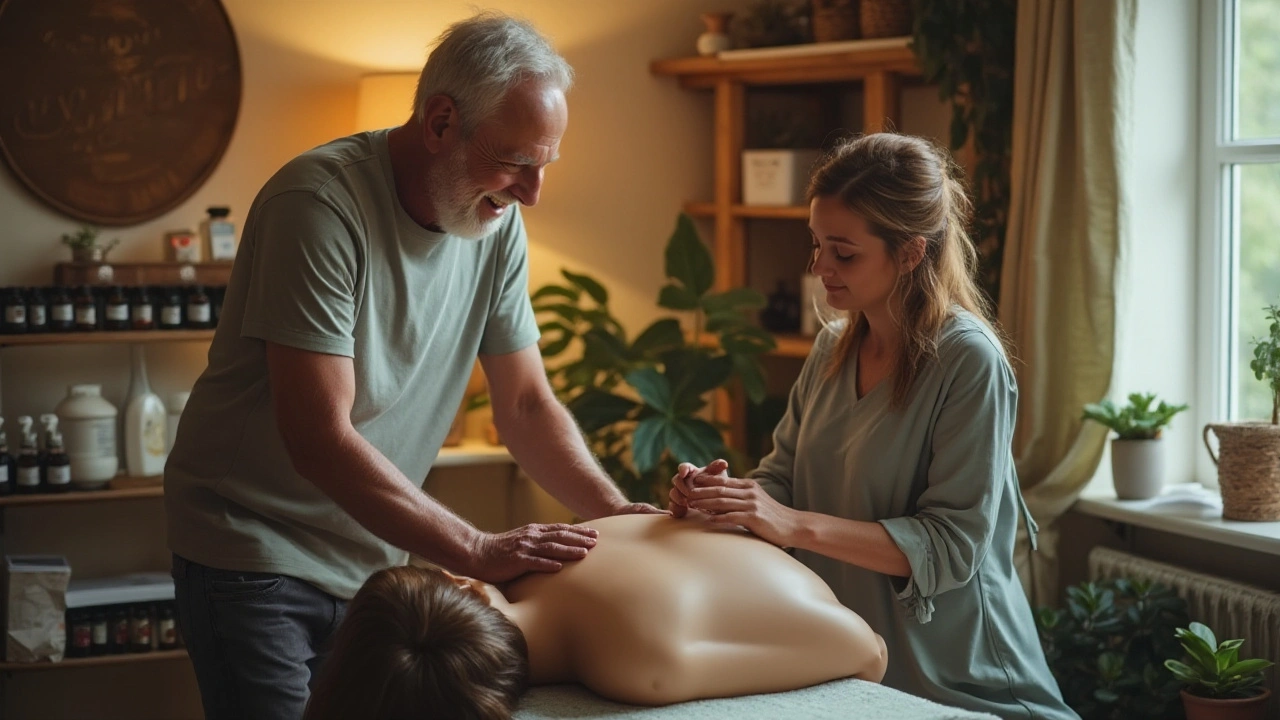Have you ever experienced that nagging pain in your shoulder that just won't go away? It might be a trigger point—an area of tight muscle fibers that can cause discomfort and even referred pain. Understanding how to manage these points through massage can be a game changer for your pain management routine.
Trigger point massage is a technique aiming to relieve these specific areas of tension, offering relief and promoting relaxation. By learning how to find and treat these points effectively, you can reduce pain and enhance your muscle function. Whether you're dealing with chronic discomfort or the occasional ache, this method can be a valuable tool in your self-care arsenal.
This comprehensive guide will walk you through the basics of identifying trigger points, the benefits of addressing them, and practical massage techniques that you can try at home or with a professional. Unlock the potential of your body's healing abilities and discover a path to a more pain-free life.
- Understanding Trigger Points
- Benefits of Trigger Point Massage
- Identifying Your Trigger Points
- Techniques for Effective Massage
- Tips for Maximizing Pain Relief
Understanding Trigger Points
Trigger points, often referred to as muscle knots, are spots within a muscle that become hyper-irritable due to stress, overuse, or injury. These areas can cause direct pain or discomfort and, interestingly, may also cause referred pain in seemingly unrelated parts of the body. Have you ever felt a dull ache in your arm that originated from a spot in your upper back? That's a classic example of referred pain from a trigger point. Understanding how these trigger points work requires a closer look at the way our muscles are wired and how they can develop tight spots.
The concept of trigger points was pioneered by Dr. Janet Travell, who defined them as "hyperirritable spots in skeletal muscle that are associated with palpable nodules in taut bands of muscle fibers." These nodules, when pressed, can produce pain locally and can also trigger referred pain patterns. The recognition and documentation of trigger points have dramatically changed how pain is diagnosed and treated. They add an extra layer of complexity when assessing muscular issues, as the true source of pain is not always immediately apparent.
Trigger Point Massage therapy specifically targets these points to release tension and decrease pain. The theory is that by applying direct pressure, the tightened muscle fibers can eventually relax, restoring normal function. For those who live with chronic pain conditions like fibromyalgia or tension headaches, understanding and managing trigger points can be crucial to improving quality of life. It’s fascinating how a simple method can have such a profound impact on pain relief!
The Science of Trigger Points
Delving deeper, trigger points are often focal areas of muscle spasm. Muscle spasm is a sustained contraction that can reduce blood flow, resulting in less oxygen and nutrients reaching the muscle. This poor circulation increases metabolic waste and can make the muscle hypersensitive, causing more pain. This cycle, which can seem never-ending, can be effectively broken with targeted pain relief techniques like massage, which improve circulation and reduce tension.
Thanks to advancements in modern imaging techniques, research has started to provide more concrete evidence of trigger points' existence. We now know that they manifest as small, palpable lumps or nodules within a muscle. Sensitive to touch, they can be an indication of muscular stress. Whether they stem from physical stress, such as poor posture or repetitive motion, or emotional stress, which can lead to unconscious muscle tightening, identifying these points is crucial for their treatment.
Dr. Jay Shah, a trigger point researcher, suggests that "electrophysiological and biochemical studies are providing insights into the complex nature of these points, paving the way for innovative treatments."
Recognizing and addressing these trigger points may not only alleviate the immediate pain they cause but can also prevent future complications, offering a more sustainable form of muscle therapy. Understanding that the sharp pain in your shoulder might not be rooted there is just the first step toward relief.
Benefits of Trigger Point Massage
Trigger Point Massage has emerged as a significant player in the realm of pain management and for good reason. This technique focuses on identifying nodules in muscle tissue which often go unnoticed until they become painful. Providing relief from these hidden culprits not only improves comfort but also enhances muscle functionality. One of the greatest benefits is the targeted nature of this massage. It allows for a precise approach to pain relief, tackling the specific areas causing discomfort and helping to restore balance and performance to the body.
Regularly practicing this massage can improve mobility which often gets restricted due to tight muscles and related pain. With continued treatment, adherence to this practice can lead to a notable reduction in muscle tension. For those dealing with chronic pain, this method offers a way to better manage symptoms, potentially decreasing reliance on medications. For those who cherish physical activities, trigger point massage aids in faster recovery post-exercise by reducing fatigue and preventing injury. It has been noted that athletes who incorporate this into their routine often experience an enhancement in their range of motion and a reduced chance of injury.
Pain relief aside, this method also influences stress levels much like any other form of massage. By addressing and easing muscle tension, it naturally dovetails into reducing stress, leaving individuals feeling relaxed and rejuvenated. Studies suggest that regular massages can even help improve sleep quality, assisting in forming a better sleep schedule. Improved blood circulation is another vital benefit, as the pressure applied in the massage promotes the flow of oxygen and nutrients to muscle tissues, leading to better muscle health.
"The pressure applied during a trigger point massage reduces muscle spasms, easing tension, and increasing blood flow to the affected area," notes Dr. Susan Griffith, a renowned physical therapist.
Beyond individual physical benefits, there’s a broader therapeutic aspect to consider. The personalized approach to trigger point massage often makes individuals feel cared for and understood, which can significantly improve mental health. Whether it’s a professional therapist delivering the treatment or a personal practice executed at home, the thorough nature of this technique encourages mindfulness and self-awareness. This focus not only improves physical well-being but also fosters an enhanced sense of emotional balance and clarity.

Identifying Your Trigger Points
Finding your own trigger points can feel like you’re embarking on a bit of detective work. But don't worry, it's not as tricky as it sounds. You just need some patience and a small amount of knowledge about your body. Trigger points are like microscopic knots in your muscle fibers—tense areas waiting for some attention. These spots often spring up in common problem areas like the neck, shoulders, and lower back. To identify them, start with areas where you often feel discomfort or notice a reduction in your range of motion.
Exploring your muscles can be akin to having a medical map of sorts; when you press on a trigger point, you might feel a noticeable difference compared to the surrounding tissues. It's like finding a small bead in a relaxed bed of putty. That spot could be tender, or even cause pain that radiates to another area. Most people tend to store tension in specific places based on their activities and stress levels. Close your eyes, take a few deep breaths, and slowly press into your muscles with your fingertips, moving in small circles until you encounter a tender knot.
Tips for Effective Identification
When probing these spots, it's important to apply a consistent amount of pressure. Imagine you’re pressing a ripe piece of fruit without breaking the skin—firm, yet gentle. Keep in mind, areas such as the trapezius (the large muscle that runs across the back of your neck and shoulders) can harbor multiple trigger points. Explore with both circular motions and direct pressure, and observe if the sensation changes. With experience, you’ll become more adept at recognizing these knots. Dr. Janet Travell, a pioneer in the field of pain management, once said, "Every patient carries their own doctor inside them."
Her works highlight the power of self-awareness in healing.You might be surprised at how intuitive this process can become.
As you practice identifying trigger points, you might occasionally notice involuntary twitching or muscle responses under your touch. That’s a good sign you’ve hit the right spot. Keep track of the areas where you routinely find trigger points—it might reveal patterns related to your daily activities or stressors. Consider keeping a journal; this isn’t just therapeutic, it helps track your progress and pinpoint recurring trouble areas. Remember, alleviating these spots through massage not only promises relief but gradually empowers you by elevating your understanding of your own body.
Techniques for Effective Massage
When it comes to performing an effective trigger point massage, the key lies in understanding the specific needs of your body and how to apply pressure with precision. Start by locating the tight knot in your muscle that may be causing discomfort. This is your trigger point and you'll often feel its presence as a noticeable lump or a taut band beneath your skin. Once located, the art of applying the right amount of pressure begins. Remember, firm pressure is crucial, but it should never cause unbearable pain. Aim to strike a balance where tension is alleviated without inflicting further discomfort.
A good way to start is by using your fingertips, knuckles, or even a massage tool, pressing directly on the trigger point. Hold the pressure steady, allowing it to penetrate deeply into the tissue, which may take a few seconds to a couple of minutes. This technique is sometimes referred to as ischemic compression. The idea is to decrease the blood flow temporarily which, paradoxically, can bring about increased circulation and relaxation once released. During this time, breathe deeply to help your muscles relax and start to release.
Another technique involves using a rhythmic kneading motion. By employing circular movements at different speeds, you can help improve circulation and promote healing in the affected area. Begin slowly, allowing the muscle to adjust to the pressure, and gradually increase the intensity as the tension starts to diminish. This method works wonders for stimulating blood flow, delivering oxygen, and other essential nutrients directly to stressed muscles.
Various Tools and Their Uses
Using tools can enhance the effectiveness of your massage techniques significantly. A foam roller, for instance, is excellent for larger muscle groups such as the legs and back, allowing for a broader application of pressure. For more localized points, a tennis ball or a massage ball can be very beneficial. By using these tools, you can apply focused pressure without straining your fingers or hands. As you roll the ball under the body part, control the pressure carefully to avoid aggravating the muscle.
"Massage therapy doesn’t just help with physical relief; it’s also a boon for mental health, offering relaxation and a sense of well-being," notes Dr. Janet Travell, a pioneer in studying trigger points.
It is crucial to remember that these exercises should be followed by proper hydration and gentle stretching to further ease muscle stress and prevent future tightness. Time and patience are important components; it's unlikely you’ll achieve complete relief in a single session, particularly for chronic conditions. Consistency breeds results, so incorporate these techniques into your regular wellness routine for the best outcome.
Monitoring Progress and Adjusting Techniques
Keep track of your progress diligently. Maintaining a simple journal can help you note down how you feel after each session, any patterns you observe, and the specific techniques that seem to work best for you. This can assist you in tailoring a more personalized plan over time, ensuring that you focus on the areas that truly need attention. Also, listen to your body—respond accordingly if a particular method isn’t delivering the desired results and be open to trying alternatives.
Here is a simple table of common tools and their purposes to help you choose what suits you best:
| Tool | Purpose |
|---|---|
| Foam Roller | Great for large muscles like thighs and back |
| Tennis Ball | Ideal for precise pressure on smaller areas |
| Thera Cane | Excellent for hard-to-reach spots |
| Lacrosse Ball | Useful for deeper pressure on large muscles |

Tips for Maximizing Pain Relief
When it comes to getting the most out of your trigger point massage, incorporating a few strategic tips can make all the difference in the world. One of the simplest, yet most powerful strategies is consistency. The more regularly you address those stubborn muscle knots, the better your body will respond over time. Consistency in massage helps muscle memory develop, aiding muscles to relax more easily in the future. A scheduled routine can result in lower overall stress levels, contributing to holistic well-being. On the days you get your massage, drink plenty of water afterwards to flush out any toxins released during the process. Staying hydrated can reduce soreness and speed up recovery.
Another important aspect to consider is using the correct pressure during your massage. Start by understanding your own pain threshold and comfort levels. Often, people think 'no pain, no gain' applies to massages as well, but this is a common mistake. Applying too much force may lead to increased muscle tension instead of relief. Try different techniques to find the perfect balance that works best for you. Incorporating gentle stretching before and after the massage can also enhance its effects, promoting greater flexibility and helping to prevent future occurrences of tightness.
Using Tools to Enhance Massage Effectiveness
For those who want to take their massage therapy to the next level, consider integrating various tools into your routine. Foam rollers, massage balls, and specialized tools can target trigger points with precision. For example, a tennis ball can work wonders when addressing hard-to-reach areas such as the back or shoulders. Simply place the ball between your body and a firm surface, like a wall, and gently roll to apply pressure. This method can be both empowering and cost-effective.Listening to your body is equally crucial when maximizing pain relief. Be attentive to your body's signals and understand when to rest and when to push on. Combining your efforts with complementary therapies such as relaxation techniques, yoga, or tai chi can help enhance the overall results of your trigger point massage. Stress management is an essential component, as stress can contribute to muscle tension. Regular practice of these activities may lead to improved mental health and physical endurance, making your massages even more effective.
"The power of massage therapy lies in its ability to harmonize the body's systems, ultimately aiding in a more balanced and pain-free state," says renowned physiotherapist, Dr. Sophia Jensen.
Personalizing Your Massage Experience
Lastly, a personalized approach is often the most successful. Everyone’s body is unique, which means a one-size-fits-all method may not suffice. Tailor your massages to target particular areas needing attention, and don't shy away from experimenting with different techniques and pressures to find your perfect fit. Keeping a massage journal can be a helpful tool in recording what techniques worked best and documenting your progress over time. Each session can provide valuable insights into what helps relieve your discomfort efficiently, which can, in turn, be applied to future sessions.By embracing these practical tips and creating a consistent, thoughtful massage routine, you'll be well on your way to experiencing the full benefits that trigger point massage has to offer. Not only will these strategies help to alleviate pain and muscle tension, but they will also contribute to an enhanced overall sense of well-being and quality of life.
